Suitability of the Reforming-Controlled Compression Ignition Concept for UAV Applications
Abstract
1. Introduction
2. Methods
2.1. RefCCI Concept Description
2.2. Model Description
2.3. Second-Law Analysis
3. Results and Discussion
3.1. Boosted RefCCI Analysis
3.1.1. The Effect of Boosting on RefCCI Engine Behavior
3.1.2. Exergy and Energy Analysis
3.2. Comparison between the RefCCI Concept and HP-TCR and a Commercial SI Engine
4. Summary and Conclusions
- Increasing compression pressure ratio consistently increases the gross indicated efficiency of the RefCCI system, but this has also an opposite effect reflected in the pumping work increase. The net indicated efficiency has a maximum value where the first effect is the most dominant.
- The necessary fuel reactivity (H2/DME ratio) varies only slightly with the increase of the compression pressure ratio and actually shows some volatility because of its opposite effects on autoignition timing. Increasing the compression pressure ratio, on the one hand, increases average pressure before combustion, but, on the other hand, decreases average temperature owing to the excess air dilution effect.
- The RefCCI method seems to be a good alternative candidate for UAV application since, despite the relatively low heating value of DME, the high system efficiency leads to fuel consumption very close to that of the conventional gasoline engine.
- The results of the RefCCI system performance optimization show that a significant reduction in the reforming exergy destruction and the exergy lost with the exhaust flow can be achieved. This results in an improvement of almost 4% in the second-law efficiency of the boosted RefCCI system. We believe that extensive optimization including more parameters than those investigated in this work can lead to even higher improvement.
Author Contributions
Funding
Conflicts of Interest
Nomenclature
| ATDC | after top dead center | SRD | steam reforming of dimethyl ether |
| BBDC | before bottom dead center | SRM | methanol steam reforming |
| BDC | bottom dead center | ||
| BTDC | before top dead center | specific chemical exergy | |
| CAI | compression auto ignition | exergy destruction rate | |
| CR | compression ratio | specific flow exergy | |
| DME | dimethyl ether | specific thermo-mechanical exergy | |
| EOI | end of injection | mass flow rate | |
| EVO | exhaust valve open | specific entropy | |
| HALE | high altitude long endurance | heat capacity ratio | |
| HP-TCR | high-pressure thermochemical recuperation | compressor efficiency | |
| HRR | heat release rate | engine second-law efficiency | |
| ICE | internal combustion engine | RefCCI system efficiency | |
| IMEP | indicated mean effective pressure | RefCCI system second-law efficiency | |
| ISFC | indicated specific fuel consumption | turbine efficiency | |
| LHV | lower heating value | predicted parameter i value | |
| LTC | low-temperature combustion | relative difference in parameter i value | |
| r-WGS | reverse water gas shift | predicted parameter reference value | |
| RCCI | reactivity-controlled compression ignition | ||
| RefCCI | reforming-controlled compression ignition | ||
| SI | spark ignition |
References
- Leadership Summit (panelists: Dante Boutell, Toyota Motor North America Inc.; Dave Filipe, Ford Motor Company; Timothy Frazier, Cummins Inc.; John Heywood, MIT.; John Juriga, Hyundai Motor Group; Jeff Lux, FCA US LLC). Today, Tomorrow, and the Future of Propulsion Systems? In Proceedings of the SAE World Congress, Detroit, MI, USA, 11 April 2019.
- Senecal, K. End of the ICE Age? The Premature Burial of Internal Combustion. In Proceedings of the SAE High Efficiency IC Engine Symposium, Detroit, MI, USA, 8 April 2019. [Google Scholar]
- Reitz, R.D.; Ogawa, H.; Payri, R.; Fansler, T.; Kokjohn, S.; Moriyoshi, Y.; Agarwal, A.K.; Arcoumanis, D.; Assanis, D.; Bae, C.; et al. IJER editorial: The future of the internal combustion engine. Int. J. Engine Res. 2020, 21, 3–10. [Google Scholar] [CrossRef]
- Yao, M.; Zheng, Z.; Liu, H. Progress and recent trends in homogeneous charge compression ignition (HCCI) engines. Prog. Energy Combust. Sci. 2009, 35, 398–437. [Google Scholar] [CrossRef]
- Saxena, S.; Bedoya, I.D. Fundamental phenomena affecting low temperature combustion and HCCI engines, high load limits and strategies for extending these limits. Prog. Energy Combust. Sci. 2013, 39, 457–488. [Google Scholar] [CrossRef]
- Kokjohn, S.L.; Hanson, R.M.; Splitter, D.A.; Reitz, R.D. Fuel reactivity controlled compression ignition (RCCI): A pathway to controlled high-efficiency clean combustion. Int. J. Engine Res. 2011, 12, 209–226. [Google Scholar] [CrossRef]
- Eyal, A.; Tartakovsky, L. Reforming-Controlled Compression Ignition—A method combining benefits of Reactivity-Controlled Compression Ignition and High-Pressure Thermochemical Recuperation; SAE International: Warrendale, PA, USA, 2019; SAE Technical Paper 2019-01-0964. [Google Scholar]
- Eyal, A.; Tartakovsky, L. Reforming Controlled Homogeneous Charge Compression Ignition—Simulation Results; SAE International: Warrendale, PA, USA, 2016; SAE Technical Paper 2016-32-0014. [Google Scholar]
- Eyal, A.; Tartakovsky, L. Second-law analysis of the reforming-controlled compression ignition. Appl. Energy 2020, 263, 114622. [Google Scholar] [CrossRef]
- Tartakovsky, L.; Sheintuch, M. Fuel reforming in internal combustion engines. Prog. Energy Combust. Sci. 2018, 67, 88–114. [Google Scholar] [CrossRef]
- Tartakovsky, L.; Baibikov, V.; Gutman, M.; Mosyak, A.; Veinblat, M. Performance Analysis of SI Engine Fueled by Ethanol Steam Reforming Products; SAE International: Warrendale, PA, USA, 2011; SAE Technical Paper 2011-01-1992. [Google Scholar]
- Tartakovsky, L.; Amiel, R.; Baibikov, V.; Fleischman, R.; Gutman, M.; Poran, A.; Veinblat, M. SI Engine with Direct Injection of Methanol Reforming Products—First Experimental Results; SAE International: Warrendale, PA, USA, 2015; SAE Technical Paper 2015-32-0712. [Google Scholar]
- Poran, A.; Tartakovsky, L. Energy Efficiency of a Direct-Injection Internal Combustion Engine with High-Pressure Methanol Steam Reforming. Energy 2015, 88, 506–514. [Google Scholar] [CrossRef]
- Poran, A.; Thawko, A.; Eyal, A.; Tartakovsky, L. Direct injection internal combustion engine with high-pressure thermochemical recuperation–Experimental study of the first prototype. Int. J. Hydrog. Energy 2018, 43, 11969–11980. [Google Scholar] [CrossRef]
- Cocco, D.; Tola, V.; Cau, G. Performance evaluation of chemically recuperated gas turbine (CRGT) power plants fuelled by di-methyl-ether (DME). Energy 2006, 31, 1446–1458. [Google Scholar] [CrossRef]
- Semelsberger, T.A.; Borup, R.L.; Greene, H.L. Dimethyl ether (DME) as an alternative fuel. J. Power Sources 2006, 156, 497–511. [Google Scholar] [CrossRef]
- McAllister, S.; Chen, J.Y.; Fernandez-Pello, A.C. Fundamentals of Combustion Processes; Springer: New York, NY, USA, 2011. [Google Scholar]
- Teng, H.; McCandless, J.; Schneyer, J. Thermodynamic Properties of Dimethyl Ether—An Alternative Fuel for Compression-Ignition Engines; SAE International: Warrendale, PA, USA, 2004; SAE Technical Paper 2004-01-0093. [Google Scholar]
- Razmara, M.; Bidarvatan, M.; Shahbakhti, M.; Robinett, R.D., III. Optimal exergy-based control of internal combustion engines. Appl. Energy 2016, 183, 1389–1403. [Google Scholar] [CrossRef][Green Version]
- Bejan, A. Advanced Engineering Thermodynamics; John Wiley & Sons: Hoboken, NJ, USA, 2016. [Google Scholar]
- Ma, B.; Yao, A.; Yao, C.; Wu, T.; Wang, B.; Gao, J.; Chen, C. Exergy loss analysis on diesel methanol dual fuel engine under different operating parameters. Appl. Energy 2020, 261, 114483. [Google Scholar] [CrossRef]
- Dincer, I.; Cengel, Y.A. Energy, Entropy and Exergy Concepts and Their Roles in Thermal Engineering. Entropy 2001, 3, 116–149. [Google Scholar] [CrossRef]
- Yazdi, M.R.M.; Aliehyaei, M.; Rosen, M.A. Exergy, Economic and Environmental Analyses of Gas Turbine Inlet Air Cooling with a Heat Pump Using a Novel System Configuration. Sustainability 2015, 7, 14259–14286. [Google Scholar] [CrossRef]
- Jin, Y.; Du, J.; Li, Z.; Zhang, H. Second-Law Analysis of Irreversible Losses in Gas Turbines. Entropy 2017, 19, 470. [Google Scholar] [CrossRef]
- Siefert, N.S.; Narburgh, S.; Chen, Y. Comprehensive Exergy Analysis of Three IGCC Power Plant Configurations with CO2 Capture. Energies 2016, 9, 669. [Google Scholar] [CrossRef]
- Tian, Z.; Yue, Y.; Zhang, Y.; Gu, B.; Gao, W. Multi-Objective Thermo-Economic Optimization of a Combined Organic Rankine Cycle (ORC) System Based on Waste Heat of Dual Fuel Marine Engine and LNG Cold Energy Recovery. Energies 2020, 13, 1397. [Google Scholar] [CrossRef]
- Dunbar, W.R.; Lior, N. Sources of combustion irreversibility. Combust. Sci. Technol. 1994, 103, 41–61. [Google Scholar] [CrossRef]
- Khaljani, M.; Saray, R.K.; Bahlouli, K. Evaluation of a combined cycle based on an HCCI (Homogenous Charge Compression Ignition) engine heat recovery employing two organic Rankine cycles. Energy 2016, 107, 748–760. [Google Scholar] [CrossRef]
- Szybist, J.P.; Chakravathy, K.; Daw, C.S. Analysis of the impact of selected fuel thermochemical properties on internal combustion engine efficiency. Energy Fuels 2012, 26, 2798–2810. [Google Scholar] [CrossRef]
- Li, Y.; Jia, M.; Chang, Y.; Kokjohn, S.L.; Reitz, R.D. Thermodynamic energy and exergy analysis of three different engine combustion regimes. Appl. Energy 2016, 180, 849–858. [Google Scholar] [CrossRef]
- Zheng, J.; Caton, J.A. Second law analysis of a low temperature combustion diesel engine: Effect of injection timing and exhaust gas recirculation. Energy 2012, 38, 78–84. [Google Scholar] [CrossRef]
- Tahmasebzadehbaie, M.; Sayyaadi, H.; Sohani, A.; Pedram, M.Z. Heat and mass recirculations strategies for improving the thermal efficiency and environmental emission of a gas-turbine cycle. Appl. Therm. Eng. 2017, 125, 118–133. [Google Scholar] [CrossRef]
- Chuahy, F.D.; Kokjohn, S.L. High efficiency dual-fuel combustion through thermochemical recovery and diesel reforming. Appl. Energy 2017, 195, 503–522. [Google Scholar] [CrossRef]
- Kaiser, E.W.; Wallington, T.J.; Hurley, M.D.; Platz, J.; Curran, H.J.; Pitz, W.J.; Westbrook, C.K. Experimental and modeling study of premixed atmospheric-pressure dimethyl ether–air flames. J. Phys. Chem. A 2000, 104, 8194–8206. [Google Scholar] [CrossRef]
- Moran, M.J.; Shapiro, H.N.; Boettner, D.D.; Bailey, M.B. Fundamentals of Engineering Thermodynamics, 8th ed.; John Wiley & Sons: Hoboken, NJ, USA, 2012. [Google Scholar]
- NASA, Glenn Research Center, Chemical Equilibrium with Applications. Available online: https://www.grc.nasa.gov/www/CEAWeb/ceaThermoBuild.htm (accessed on 21 August 2019).
- Engineering ToolBox—Resources, Tools and Basic Information for Engineering and Design of Technical Applications! Available online: https://www.engineeringtoolbox.com/standard-atmosphere-d_604.html (accessed on 10 August 2020).
- Oar-Arteta, L.; Aguayo, A.T.; Remiro, A.; Arandia, A.; Bilbao, J.; Ana, G. Gayubo. Kinetics of the steam reforming of dimethyl ether over CuFe2O4/γ-Al2O3. Chem. Eng. J. 2016, 306, 401–412. [Google Scholar] [CrossRef]
- Fass, Y.; Tartakovsky, L. Limitations of Two-Stage Turbocharging at High Flight Altitudes. SAE Int. J. Engines 2018, 11, 511–524. [Google Scholar] [CrossRef]
- Chakravarthy, V.K.; Daw, C.S.; Pihl, J.A.; Conklin, J.C. Study of the theoretical potential of thermochemical exhaust heat recuperation for internal combustion engines. Energy Fuels 2010, 24, 1529–1537. [Google Scholar] [CrossRef]
- Amiel, R.; Tartakovsky, L. Effect of Flight Altitude on the Knock Tendency of SI Reciprocating Turbocharged Engines; SAE International: Warrendale, PA, USA, 2016; SAE Technical Paper 2016-32-0006. [Google Scholar]
- Thawko, A.; Persy, S.A.; Eyal, A.; Tartakovsky, L. Effects of Fuel Injection Method on Energy Efficiency and Emissions of SI Engine Fed with A Hydrogen-Rich Reformate (No. 2020-01-2082); SAE International: Warrendale, PA, USA, 2020; SAE Technical Paper 2020-01-2082. [Google Scholar]

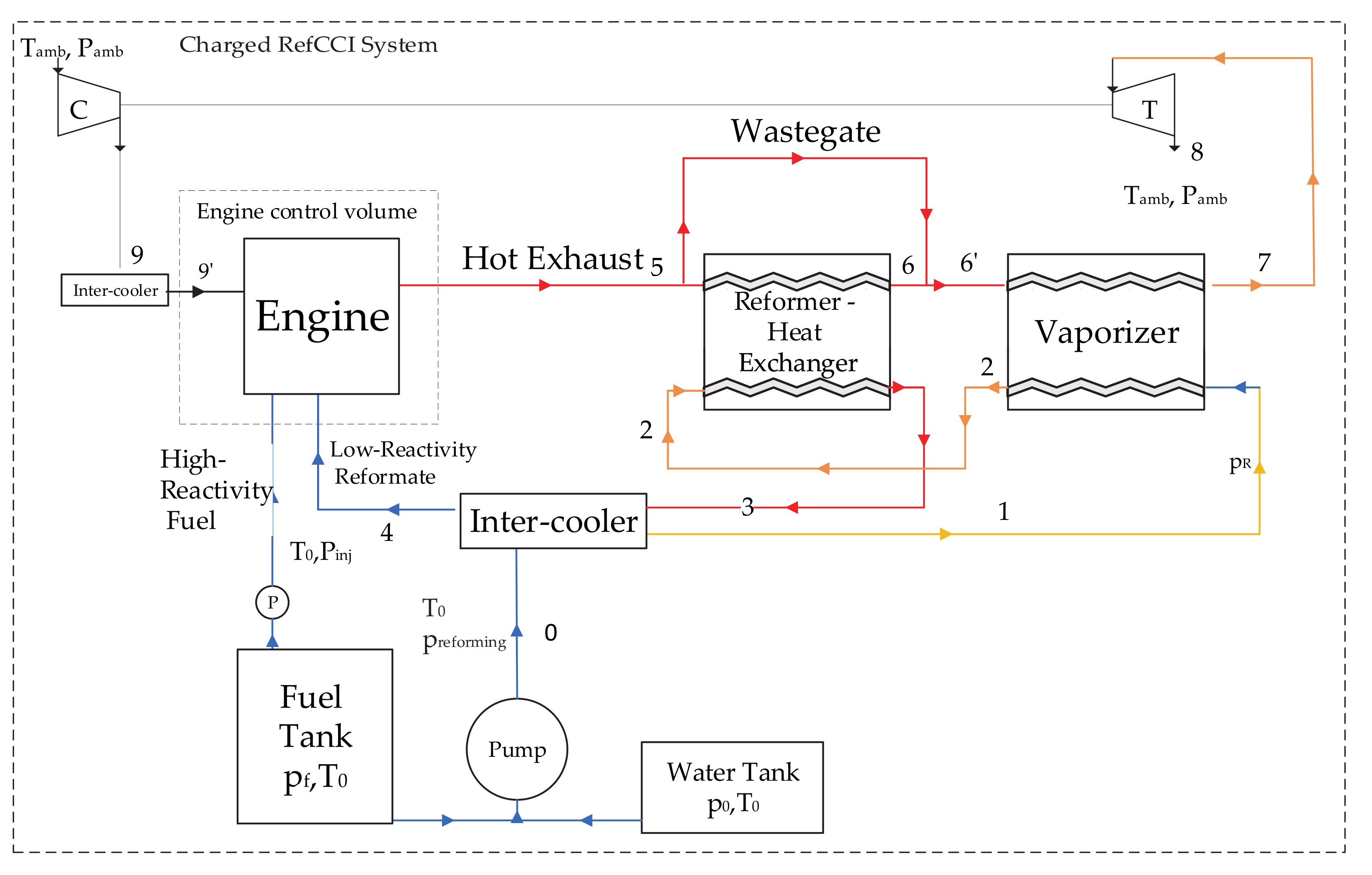
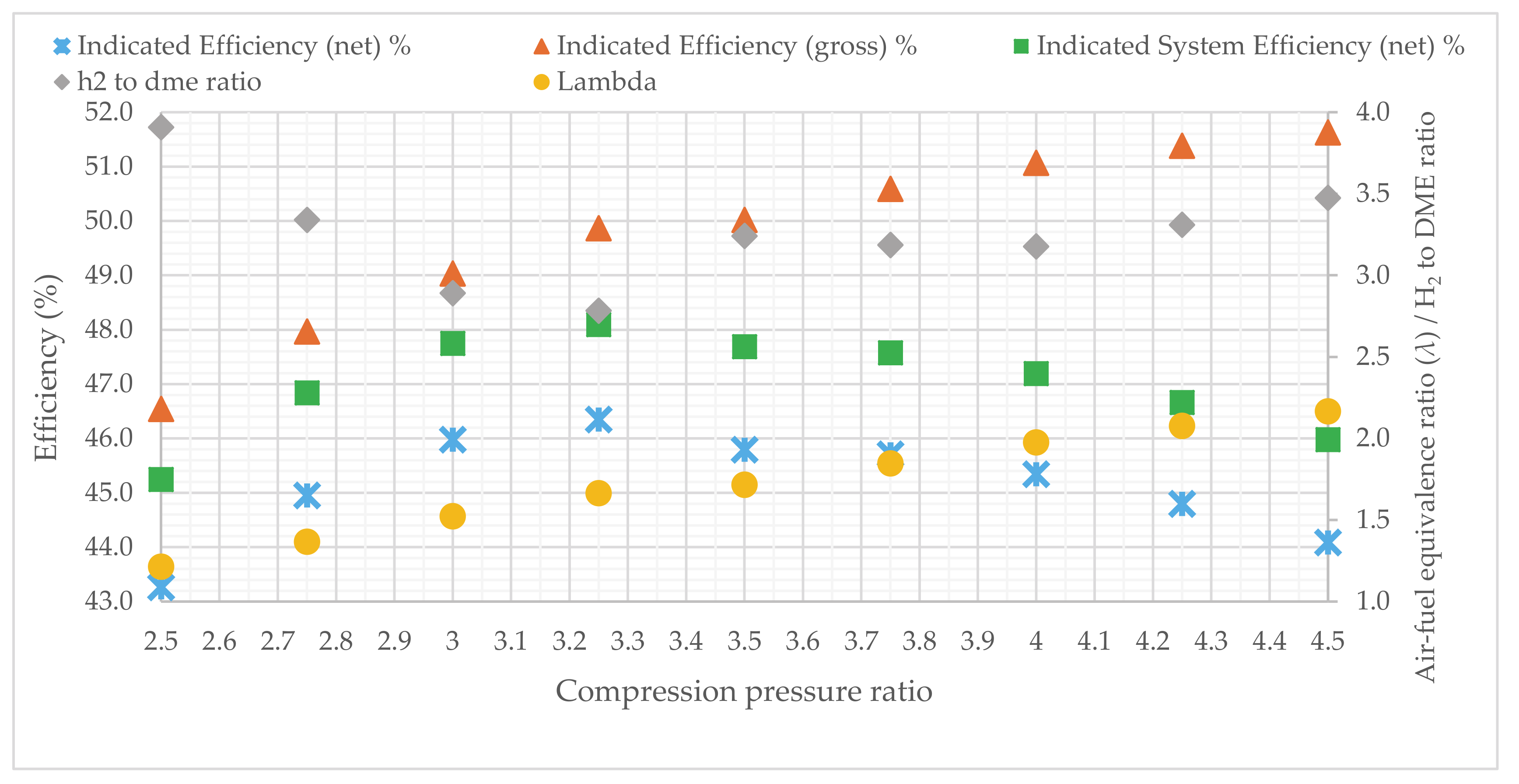
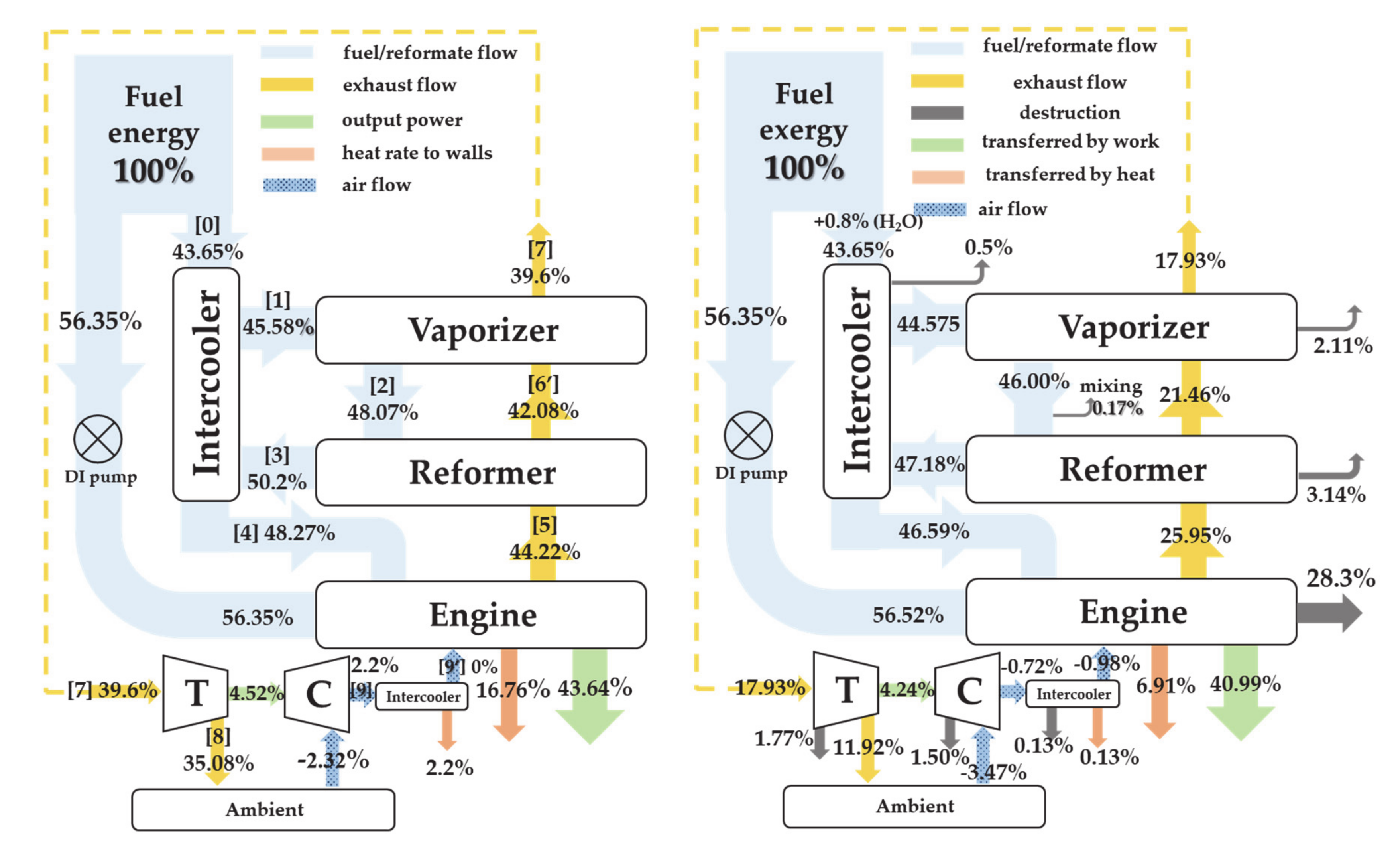
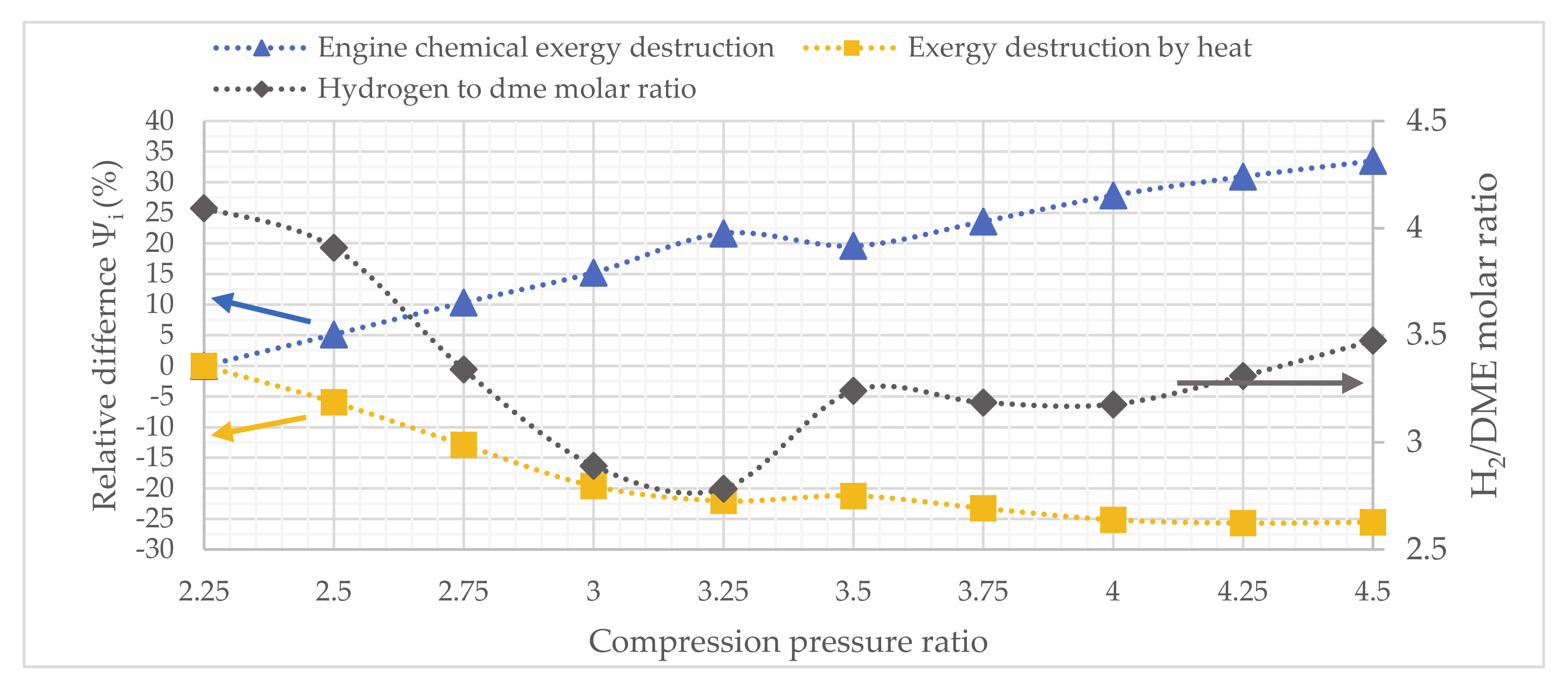
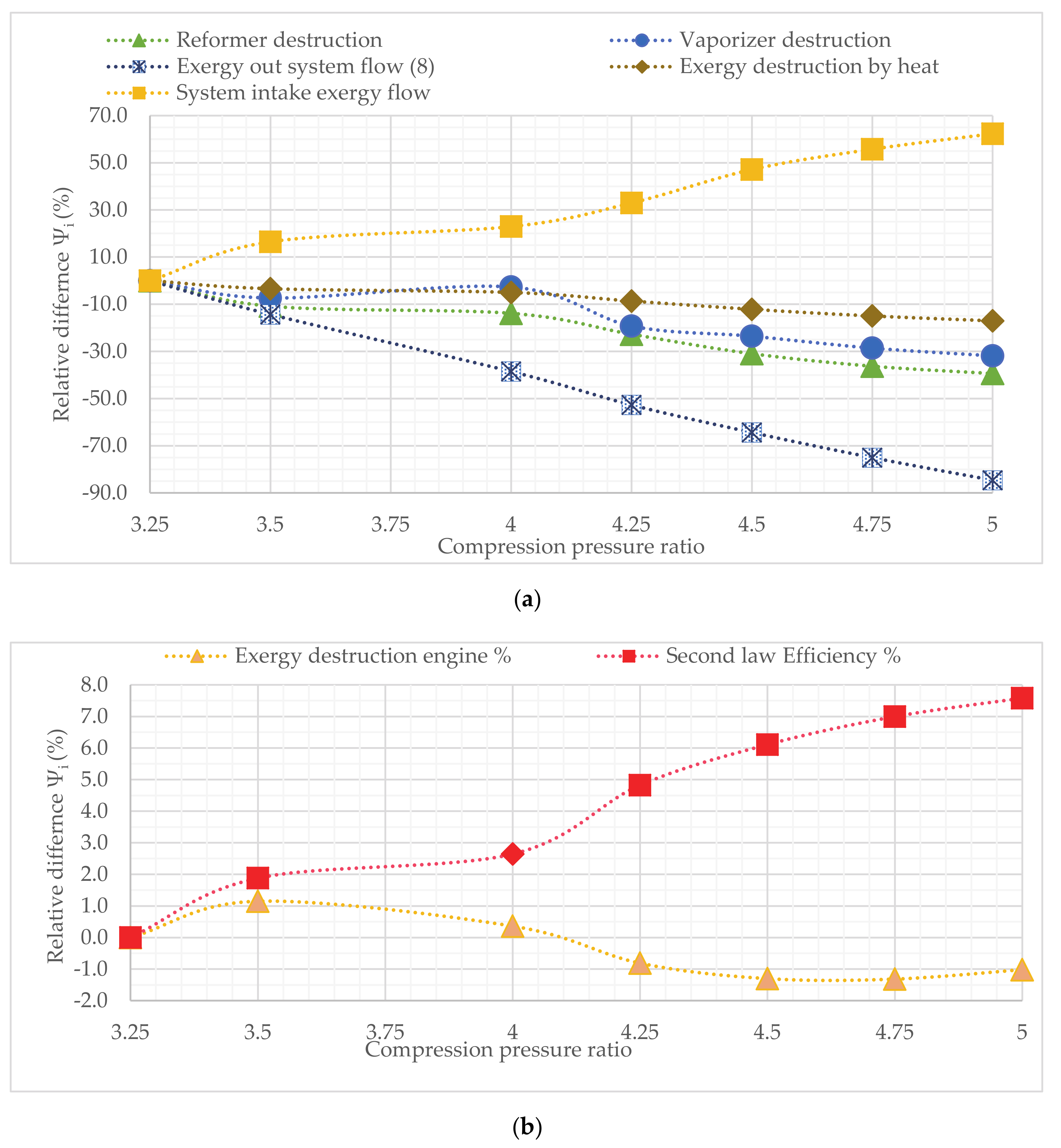
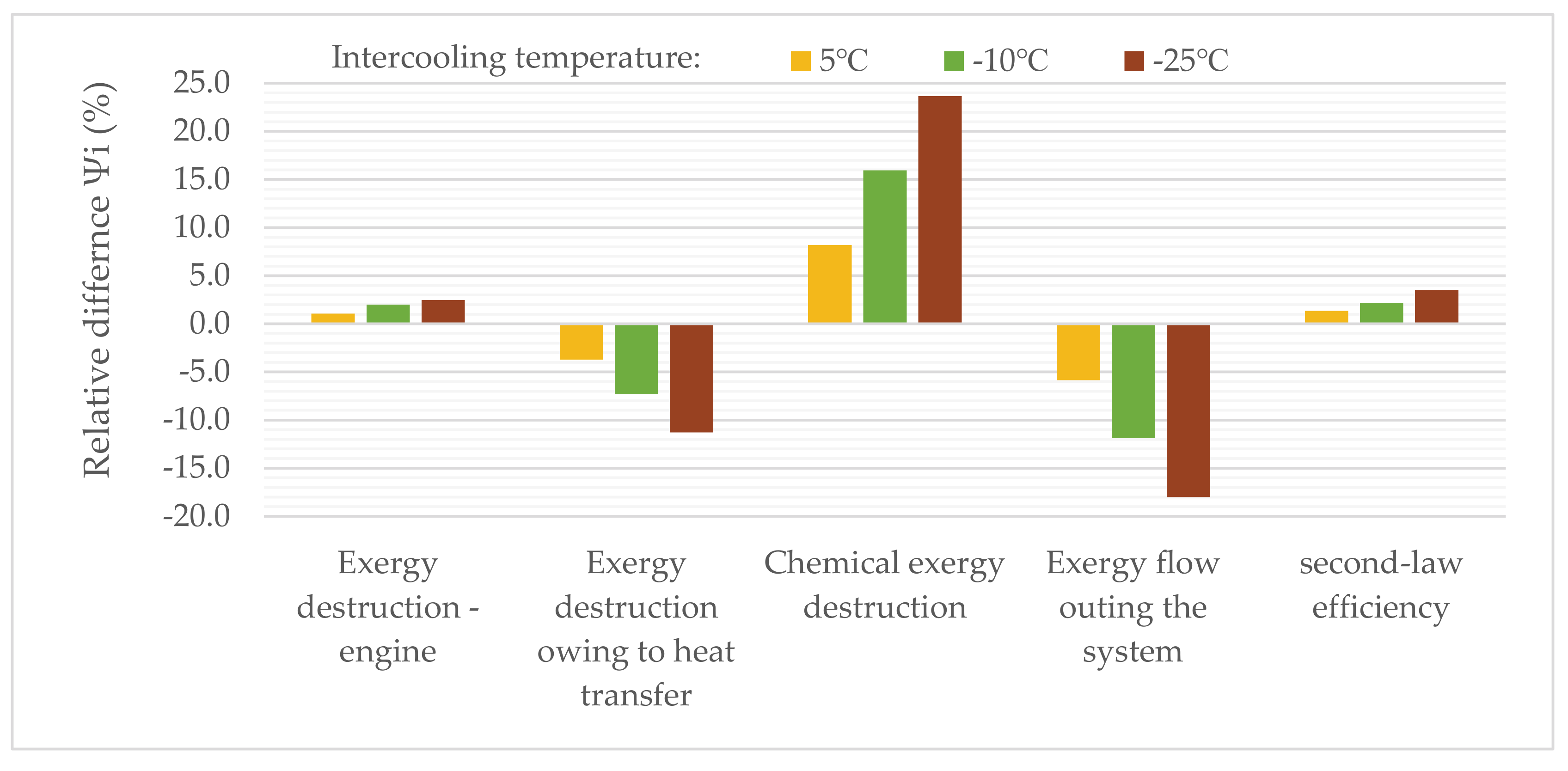
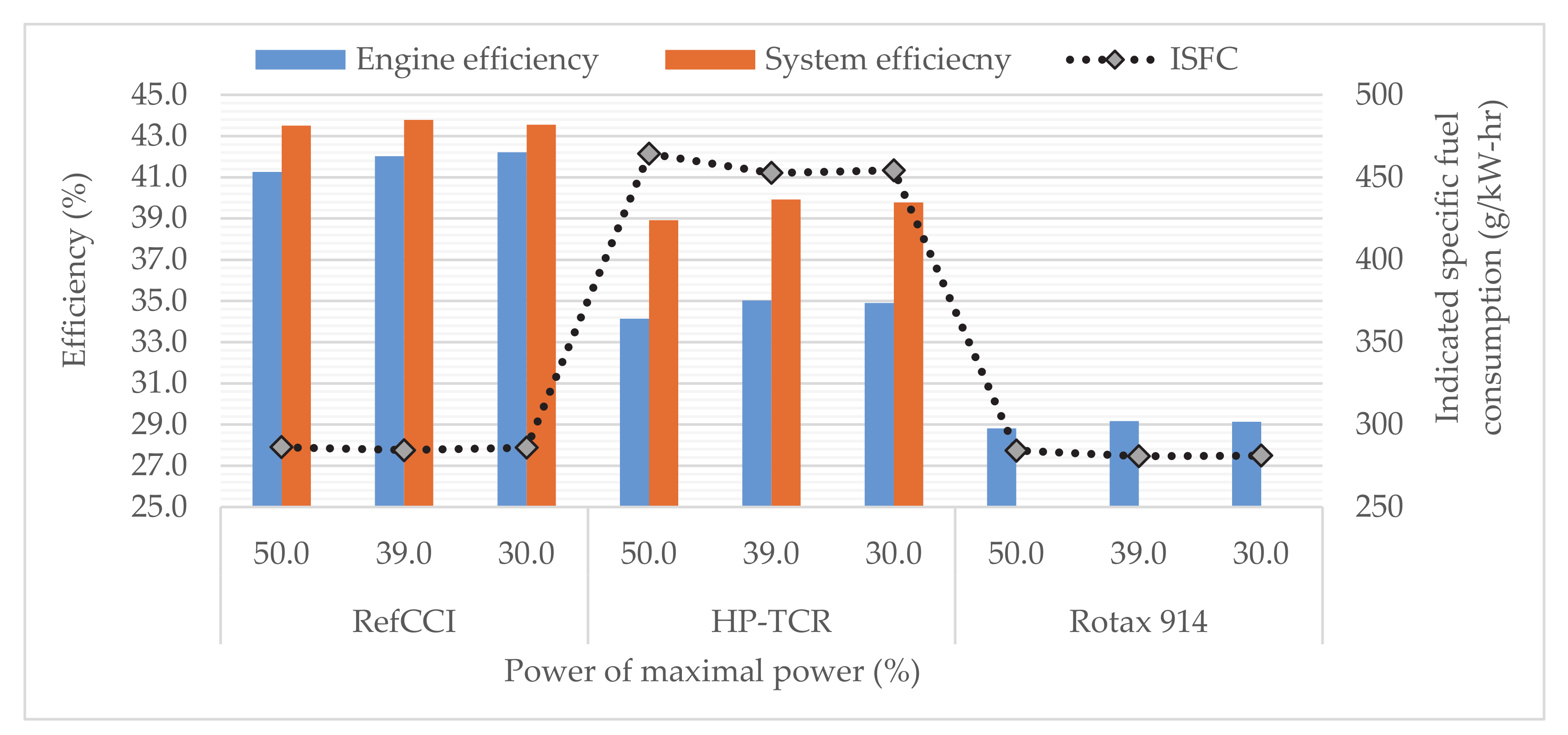
| Hydrogen | Dimethyl-ether | Methanol | Gasoline | |
|---|---|---|---|---|
| Chemical formula | H2 | CH3OCH3 | CH3OH | - |
| Molecular mass (g/mol) | 2.02 | 46.07 | 32.4 | - |
| Chemical exergy [MJ/kg] | 116.69 | 30.71 | 22.48 | 47.4 (octane) |
| Lower heating value (MJ/kg) | 119.96 1 | 28.9 2 | 19.92 | 44.0 |
| Stoic. air to fuel ratio (kgair/kgfuel) | 34.3 | 9.0 | 6.45 | 14.7 |
| Flammability limits by λ 3 | 0.14–10.08 | 0.19–1.99 | 0.25–1.95 | 0.26–1.62 |
| Type | Four-Stroke/Single-Cylinder |
|---|---|
| Displaced volume | 367 cm 3 |
| Stroke | 73 mm |
| Bore | 80 mm |
| Connecting rod length | 126 mm |
| Compression ratio | 16:1 |
| Number of valves | 2 |
| Exhaust valve open | 38° BBDC @ 0.15 mm lift |
| Exhaust valve close | 4° ATDC @ 0.15 mm lift |
| Intake valve open | 28° BTDC @ 0.15 mm lift |
| Intake valve close | 4° BBDC @ 0.15 mm lift |
| Relative difference | Reformer destruction | Vaporizer destruction | Intercooler destruction | Engine exergy destruction | Exergy flowing out the system | Intake exergy flow | Second-law efficiency |
| Ψi (%) | −33.4% | −59.0% | −41.3% | +3.7% | −20.6% | 12.0% | 3.8% |
| Parameter | Injection/reforming pressure (bar) | Injection end of DME (deg. BTDC) | Reformer heat transfer area (m2) | Intercooling temperature(°C) | Compression pressure ratio | ||
| Reference/ optimized | 25/45 | 60/40 | 0.63/0.79 | 25/(−25) | 3.25/3.25 | ||
| Modeled Engine | Concept | Compression Ratio | Primary Fuel (LHV– MJ/kg) | Combusted Fuel | Remarks |
|---|---|---|---|---|---|
| 1 Rotax 914 | SI | 9:1 | Gasoline (44) | Gasoline | CR is limited by ringing |
| 2 Lester Petter AD1 | HP-TCR | 16:1 | Methanol (19.9) | Hydrogen | CR is greater owing to hydrogen knock resistance character |
| 3 Lester Petter AD1 | RefCCI | 16:1 | DME (28.9) | DME+ hydrogen | Compression autoignition |
© 2020 by the authors. Licensee MDPI, Basel, Switzerland. This article is an open access article distributed under the terms and conditions of the Creative Commons Attribution (CC BY) license (http://creativecommons.org/licenses/by/4.0/).
Share and Cite
Eyal, A.; Tartakovsky, L. Suitability of the Reforming-Controlled Compression Ignition Concept for UAV Applications. Drones 2020, 4, 60. https://doi.org/10.3390/drones4030060
Eyal A, Tartakovsky L. Suitability of the Reforming-Controlled Compression Ignition Concept for UAV Applications. Drones. 2020; 4(3):60. https://doi.org/10.3390/drones4030060
Chicago/Turabian StyleEyal, Amnon, and Leonid Tartakovsky. 2020. "Suitability of the Reforming-Controlled Compression Ignition Concept for UAV Applications" Drones 4, no. 3: 60. https://doi.org/10.3390/drones4030060
APA StyleEyal, A., & Tartakovsky, L. (2020). Suitability of the Reforming-Controlled Compression Ignition Concept for UAV Applications. Drones, 4(3), 60. https://doi.org/10.3390/drones4030060






